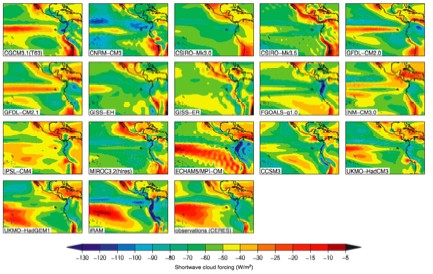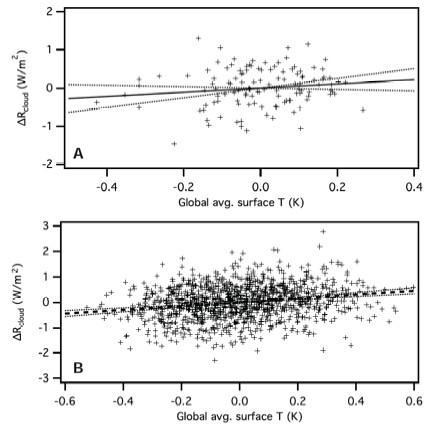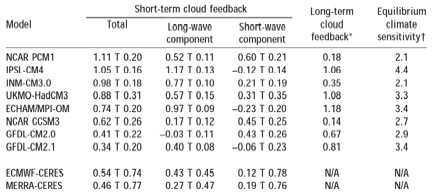
What The Science Says:
Although the cloud feedback is one of the largest remaining uncertainties in climate science, evidence is building that the net cloud feedback is likely positive, and unlikely to be strongly negative.
Climate Myth: Clouds provide negative feedback
"Climate models used by the International Panel on Climate Change (IPCC) assume that clouds provide a large positive feedback, greatly amplifying the small warming effect of increasing CO2 content in air. Clouds have made fools of climate modelers. A detailed analysis of cloud behavior from satellite data by Dr. Roy Spencer of the University of Alabama in Huntsville shows that clouds actually provide a strong negative feedback, the opposite of that assumed by the climate modelers. The modelers confused cause and effect, thereby getting the feedback in the wrong direction." (Ken Gregory)
One of the largest uncertainties in global climate models (GCMs) is the response of clouds in a warming world. Determining which types of cloud cover will increase or decrease, whether that will result in a net positive or negative feedback, and how large the feedback will be, are major challenges. The variation in global climate sensitivity among GCMs is largely attributable to differences in cloud feedbacks, and feedbacks of low-level clouds in particular.
For climate scientists who are skeptical that anthropogenic greenhouse gas emissions will cause a dangerous amount of warming, such as Richard Lindzen and Roy Spencer, their skepticism hinges mainly on this cloud cover uncertainty. They tend to believe that as the planet warms, low-level cloud cover will increase, thus increasing planetary albedo (overall reflectiveness of the Earth), offsetting the increased greenhouse effect and preventing a dangerous level of global warming from occurring.
Recently some studies have examined the cloud feedback specifically in the eastern Pacific region. Stowasser et al. (2006) found that:
"In terms of the sensitivity of the global-mean surface temperature, almost all the differences among the models could be attributed to differences in the shortwave cloud feedbacks in the tropical and subtropical regions."
In order to evaluate this uncertainty, Lauer et al. (2010) used 16 GCMs and the International Pacific Research Center (IPRC) Regional Atmospheric Model (iRAM) described in Lauer et al. (2009) to simulate clouds and cloud–climate feedbacks in the tropical and subtropical eastern Pacific region. To investigate cloud–climate feedbacks in iRAM, the authors ran several global warming scenarios with boundary conditions appropriate for late twenty-first-century conditions (specifically, warming signals based on IPCC AR4 SRES A1B simulations).
Figure 1 shows the results of the 16 GCMs, iRAM (bottom center), and satellite observations (bottom right). A clearer version of this figure can be seen in Figure 1 on Page 6 of Lauer et al. (2010).
"The authors find that the simulation of the present-day mean cloud climatology for this region in the GCMs is very poor and that the cloud–climate feedbacks vary widely among the GCMs. By contrast, iRAM simulates mean clouds and interannual cloud variations that are quite similar to those observed in this region."

Figure 1: Annual average TOA shortwave cloud forcing for present-day conditions from 16 IPCC AR4 models and iRAM (bottom center) compared with CERES satellite observations (bottom right)
As demonstrated by this figure, iRAM pattern most closely matches the CERES observational pattern, which indicates that iRAM simulates recently observed cloud cover changes in this the eastern Pacific more accurately than the GCMs. iRAM also successfully simulates the main features of the observed interannual variation of clouds in this region, including the evolution of the clouds through the El Niño Southern Oscillation (ENSO) cycle. Given these conclusions, the logical assumption is that iRAM will also model future cloud cover changes more accurately. Operating under this assumption, the authors conclude as follows.
\"All the global warming cases simulated with iRAM show a distinct reduction in low-level cloud amount, particularly in the stratocumulus regime, resulting in positive local feedback parameters in these regions in the range of 4–7 W m-2 K-1....The GCM feedbacks vary from -1.0 to +1.3 W m-2 K-1, which are all less than the +1.8 to +1.9 W m-2 K-1 obtained in the comparable iRAM simulations. The iRAM results by themselves cannot be connected definitively to global climate feedbacks, but we have shown that among the GCMs the cloud feedbacks averaged over 30°S–30°N and the equilibrium global climate sensitivity are both correlated strongly with the east Pacific cloud feedback. To the extent that iRAM results for cloud feedbacks in the east Pacific are credible, they provide support for the high end of current estimates of global climate sensitivity."
Other studies analyzing satellite data from the International Satellite Cloud Climatology Project (ISCCP), the Advanced Very High Resolution Radiometer (AVHRR), and the Clouds and the Earth’s Radiant Energy System (CERES) such as Chang & Coakley (2007) and Eitzen et al. (2008) have indicated that cloud optical depth of low marine clouds might be expected to decrease with increasing temperature. This suggests a positive shortwave cloud–climate feedback for marine stratocumulus decks.
In another recent paper, Clement et al. (2009) analyzed several decades of ship-based observations of cloud cover along with more recent satellite observations, with a focus on the northeastern Pacific. They found that there is a negative correlation between cloud cover and sea surface temperature apparent on a long time scale—again suggesting a positive cloud-climate feedback in this region.
The strength of the cloud feedback is commonly calculated by determining the change in cloud-caused heat flow for a change in temperature:
F = ΔRcloud /ΔTs
Where "F" is cloud feedback, ΔRcloud is the change in the top of the atmosphere (TOA) flux caused by cloud changes, and ΔTs is the global-average and monthly mean surface temperature anomaly.
If the temperature is related to clouds, then you expect a slope in the graph thanks to the above formula - a positive slope for a positive feedback, or a negative slope for a negative feedback. Figure 2 displays the results, and Dessler finds that the short term feedback is 0.54 ± 0.74 (2σ) W m-2 K-1, i.e. far more likely to be positive than negative, although negative values can’t be ruled out based on this data. However, a small negative feedback is insufficient to support the theory that clouds will prevent significant future warming.

Figure 2: (A) Scatter plot of monthly average values of ΔRcloud vs. ΔTsusing CERES and ECMWF interim data. (B) Scatter plot of monthly averages of the same quantities from 100 years of a control run of the ECHAM/MPIOM model. In all plots, the solid line is a linear least-squares fit and the dotted lines are the 2σ confidence interval of the fit.
A key point in the paper is that most of these short-term temperature changes are caused by ENSO. If the temperature change is being caused by ENSO, then it’s likely not being caused by clouds; rather, clouds are acting as a feedback, amplifying or dampening the temperature change.
Dessler (2010) adds confidence that the cloud feedback is not significantly negative, and various climate models are largely in agreement with the CERES observations, as illustrated in Table 1.
Table 1: Cloud feedback values. All uncertainties are 2σ. Feedbacks are calculated from a 100-year segment of a control run, except for CCSM3, which is based on 80 years.

Dessler is careful to point out that there are differences between short-term and long-term cloud feedbacks in models, which suggests that these observations might not be a good guide for the future. However, although long-term climate sensitivity cannot be determined from 10 years worth of data, the global climate models did pass this test, and the evidence against a strong negative cloud-climate feedback continues to mount.
Dessler & Loeb (2013) and Zhou et al. (2013) tested the robustness of the Dessler (2010) results. Zhou et al. used cloud measurement data from the Moderate Resolution Imaging Spectroradiometer (MODIS) on NASA’s Terra satellite over the same 2000–2010 timeframe, while Dessler and Leob examine how the use of different clear-sky TOA energy flux and surface temperature measurements change the results using the approach in Dessler (2010).
Dessler and Loeb found that the relatively weak but postive short-term cloud feedback found in Dessler (2010) is a robust result across many different datasets. Zhou et al. found a small but slightly negative short-term cloud feedback using the MODIS data. However, the authors conclude that the cloud feedback estimate based on MODIS data is most likely biased low, and the Dessler results are most likely accurate.
The authors of Sherwood (2014) looked at the way that the various climate models handle the cloud feedback and found models with a low climate sensitivity were inconsistent with observations. It turns out that these models were incorrectly simulating water vapor being drawn up to higher levels of the atmosphere to form clouds in a warmer world. In reality (based on observations) warming of the lower atmosphere pulls water vapor away from those higher cloud-forming levels of the atmosphere and the amount of cloud formation there actually decreases. The diminished cloud cover leads to greater warming (a positive feedback), as explained by lead author Steven Sherwood in this video.
[youtube id="_YZxqRM97eo"]
These results are consistent with Fasullo & Trenberth (2012), who found that only the higher sensitivity climate models correctly simulated drying in key cloud-forming regions of the atmosphere.
In short, while more research of the cloud-climate feedback is needed, the evidence is building against those who argue for a strongly negative cloud feedback. It\'s also important to remember that clouds are just one feedback among many, and there is a large amount of evidence that the net feedback is significantly positive, and climate sensitivity is not low.
Intermediate rebuttal written by dana1981
This rebuttal was updated by Kyle Pressler in September 2021 to replace broken links. The updates are a result of our call for help published in May 2021.
 |
The Skeptical Science website by Skeptical Science is licensed under a Creative Commons Attribution 3.0 Unported License. |